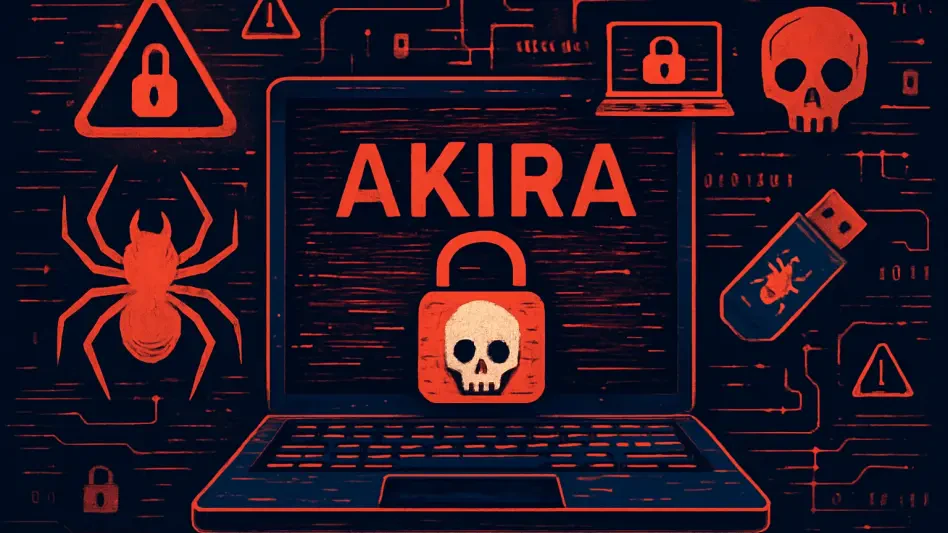In a digital landscape increasingly fraught with danger, U.S. businesses face an escalating menace from cybercriminal groups, with Akira ransomware emerging as a particularly formidable adversary that demands urgent attention. Federal cyber authorities, including the FBI and the Cybersecurity and Infrastructure Security Agency (CISA), in collaboration with international partners like Europol and agencies from France, Germany, and the Netherlands, have issued a stark warning about this threat through a joint cybersecurity advisory. Since its appearance, Akira has rapidly climbed the ranks to become one of the top five ransomware variants under FBI investigation, out of over 130 active strains targeting critical infrastructure. With over $244 million in proceeds amassed by late September of the previous year, this group predominantly targets small- and medium-sized enterprises across vital sectors such as manufacturing, education, IT, healthcare, finance, and agriculture. The scale of their impact underscores a pressing need for heightened vigilance and robust defenses against such sophisticated cyber threats.
Unveiling Akira’s Sophisticated Attack Strategies
Akira ransomware distinguishes itself through a relentless and cunning approach to cyber extortion, employing a double-extortion model that both encrypts systems and steals sensitive data to coerce victims into paying substantial ransoms. Their arsenal includes exploiting vulnerabilities in widely used technologies such as Cisco firewalls, Windows systems, VMware ESXi, Veeam Backup, and SonicWall firewalls, with six newly identified flaws highlighted in recent advisories. Beyond technical exploits, the group leverages stolen credentials, brute-force attacks, and password-spraying techniques to gain initial access. Once inside, remote access tools like AnyDesk and LogMeIn ensure persistent control over compromised networks. Perhaps most alarming is their speed—data exfiltration has been observed occurring in as little as two hours after breaching a system. This rapid execution amplifies the challenge for businesses to detect and respond before significant damage is done, positioning Akira as a uniquely dangerous player in the ransomware landscape.
The sophistication of Akira’s tactics extends beyond mere technical prowess to a networked approach that amplifies their threat level. Connections to other cybercriminal entities, such as Storm-1567 and the now-disbanded Conti ransomware group, suggest a collaborative ecosystem among threat actors that enhances their operational reach and resilience. This interconnectedness allows Akira to adapt quickly, learning from and integrating strategies from other groups to refine their attacks. Furthermore, their focus on operational security ensures that tracking and disrupting their activities remains a daunting task for law enforcement and cybersecurity professionals. The joint advisory emphasizes that Akira’s ability to exploit known vulnerabilities, like CVE-2024-40766 which impacted around 40 victims in a short span, underscores a critical need for organizations to prioritize patching and updating systems. Without such proactive measures, businesses remain vulnerable to the layered and swift attack strategies that define Akira’s modus operandi.
The Broader Ransomware Challenge and Defensive Imperatives
Ransomware continues to be the foremost cybercriminal threat identified by the FBI, with Akira serving as a stark example of the evolving dangers facing U.S. critical infrastructure. The financial toll is staggering, as remediation costs often eclipse the ransom demands themselves, placing immense economic pressure on affected organizations. FBI Assistant Director Brett Leatherman has highlighted the increasing complexity of these attacks, noting that groups like Akira employ tactics designed to maximize disruption and profit. Meanwhile, CISA’s Nick Andersen stresses the importance of bolstering defenses in response to such adaptability, clarifying that ongoing advisories aim to address the broader ransomware challenge rather than a single incident. The persistent evolution of these threats means that businesses must remain agile, continuously updating security protocols to counter sophisticated adversaries who refine their methods with alarming regularity.
Addressing the menace posed by Akira and similar ransomware groups requires a multi-faceted approach rooted in international cooperation and proactive cybersecurity measures. The joint advisory serves as a crucial resource, providing updated guidance for organizations to identify and defend against specific tactics and indicators of compromise, some of which have been observed as recently as this month. Beyond technical defenses, there is a clear consensus among authorities on the need for a cultural shift within businesses to prioritize cyber hygiene—regular software updates, employee training on phishing risks, and robust backup strategies can significantly mitigate risks. The narrative surrounding Akira reflects a microcosm of the larger battle against ransomware, where financial losses, numerous active variants, and disruptions to critical sectors demand a unified response. Only through sustained collaboration and vigilance can the tide be turned against such persistent and damaging cyber threats.
Reflecting on Past Actions and Future Safeguards
Looking back, the response to Akira ransomware revealed a critical juncture in the fight against cybercrime, where federal and international agencies united to issue detailed warnings and actionable intelligence. The substantial financial gains accrued by the group, coupled with their impact on diverse sectors, painted a sobering picture of vulnerability that many businesses grappled with in recent times. Their sophisticated techniques, from rapid data exfiltration to exploiting newly discovered vulnerabilities, underscored a period of heightened risk that tested the resilience of critical infrastructure. As the joint advisory illuminated the scale of this threat, it became evident that past efforts to combat ransomware required reevaluation to address the adaptability of groups like Akira. Moving forward, businesses were urged to integrate the lessons learned into stronger security frameworks, ensuring that the disruptions experienced served as a catalyst for lasting change in cybersecurity practices.








